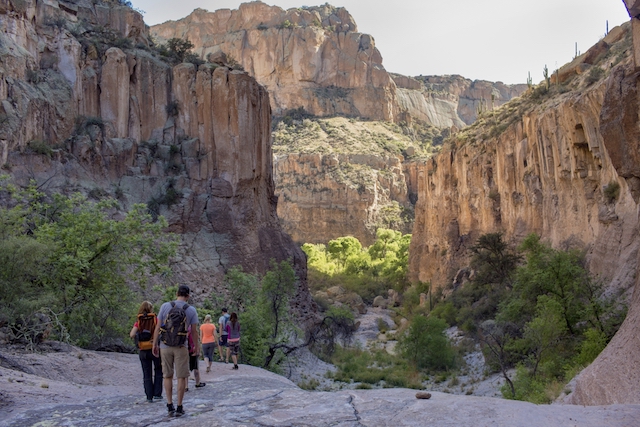
At long last, summer vacation is finally upon us. With glimpses of memorable road trips, staycation setups and weekends away in sight, locals and tourists alike are all pining after their next desert adventure, hoping they’ll find themselves wrapped up in one of so many of the state’s captivating environments and experiences.
While Arizona is home to colossal monuments, lush forest preserves and jaw-dropping national parks, the state has a reputation for finding some of its most beloved sites often overcrowded and unreachable. Licensing, permits and waitlist reservations have made it all the more difficult for people to truly enjoy the desert’s enviable beauty.
Rather than wait several months to visit your dream destination, the Arizona Office of Tourism has rounded up a list of “If Not There, Then Where?” destinations.
“Permit requirements and foot-traffic limits at some of Arizona’s most beautiful natural attractions exist for a reason—to preserve and protect these places for future generations,” says Debbie Johnson, Director of the Arizona Office of Tourism. “But we’re lucky to live in a state with such incredible geological diversity that bucket-list destinations have bucket-list alternatives. And because these parallel natural wonders tend to be less crowded or more remote, the visitor experience can be even better.”
Looking into the summer months, these hidden gems will serve as perfect substitutes for all of your adventure-seeking desires.

Photo courtesy of Arizona Outback Adventures.
If not Havasupai Falls, try Aravaipa Canyon
Havasupai Falls might be an Instagram-favorite destination, but it’s certainly not the easiest. Camping reservations and permits might complicate your chances of visiting this desert gem anytime soon. With that, you might consider paying a visit to Aravaipa Canyon Wilderness. With towering cliffs, flowing water and a rich diversity of flora and fauna, Aravaipa Canyon Wilderness remains as one of Arizona’s truly unique areas. Its 19,410 acres of designated Wilderness beckons adventurers who yearn for solitude and scenic splendor.

Photo courtesy of the Arizona Office of Tourism.
If not The Wave, try White Pocket
There’s certainly nothing like The Wave. Whether you recognize it from National Geographic as one of their favorite southwestern adventure gems or maybe even as the default photo on your Microsoft computer, the destination is undoubtedly one of Arizona’s most popular. The location and demand make the spot a bit too difficult to seamlessly visit – especially during the summer months. Your next best option, as recommended by the Arizona Office of Tourism? White Pocket. White Pocket is a group of domes and ridges covering an area of one square mile, below a larger mesa lined by similar rocks. White, or light gray, is the dominant rock color, in contrast to the red of the Coyote Buttes, but the general features are similar – swirling, thin-layered strata, adjacent layers of contrasting color, and curious erosive features. Other colorful pockets are found further south and east on the plateau. This sweet spot serves the same stellar views as The Wave, without all of the hassle.

Photo courtesy of Arizona Outback Adventures.
If not Canyon de Chelly’s canyon floor, try the White House Ruins Trail
Canyon de Chelly is protected and managed as a national monument, thus making it occasionally difficult to truly enjoy the area for not only what it is, but also for the remarkable history it still carries. Upon arrival, you might feel encouraged to pay a visit to some of the more mundane tourist hotspots, but we’d recommend that you dedicate some time to the White House Ruins Trail, in particular. All land within the park is Navajo tribal trust land, and approximately 40 Navajo families still reside in the area. Because of overlapping jurisdiction, hikers can still get a glimpse of the unparalleled history that still serves as a prominent blueprint of the monument’s DNA.
This trail in particular is 2.73 miles round trip and is noted as being a fairly easy hike – which means all the more travelers and explorers will have the opportunity to enjoy it, regardless of their stamina or hiking capabilities. The best part of this trail is a little-known destination which Navajos call Kinii’ ni gai, which translates to “white house.” The name stems from the glimpses of light-colored plaster that is visible on many of the walls of the ancient Navajo homes that you can see on the trail. Archeologists believe that several of the settlements found within the area date back to A.D. 1060. The history that has been well-preserved and well-kept – thanks in part to the limited visitors and restricted use of photography – is what sets this trail apart, making it one of Canyon de Chelly’s best-kept secrets.